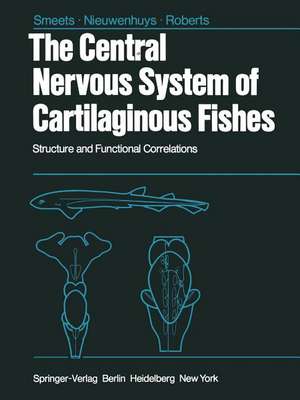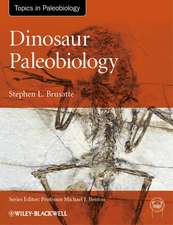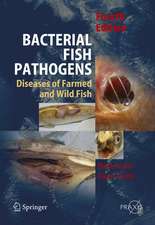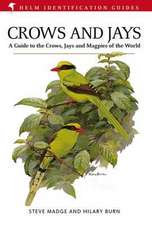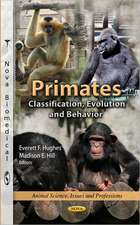The Central Nervous System of Cartilaginous Fishes: Structure and Functional Correlations
Autor W.J.A.J. Smeets, R. Nieuwenhuys, B. L. Robertsen Limba Engleză Paperback – 6 dec 2011
Preț: 648.24 lei
Preț vechi: 762.64 lei
-15% Nou
Puncte Express: 972
Preț estimativ în valută:
124.06€ • 128.16$ • 103.25£
124.06€ • 128.16$ • 103.25£
Carte tipărită la comandă
Livrare economică 26 martie-09 aprilie
Preluare comenzi: 021 569.72.76
Specificații
ISBN-13: 9783642689253
ISBN-10: 3642689256
Pagini: 280
Ilustrații: X, 268 p.
Dimensiuni: 210 x 280 x 15 mm
Greutate: 0.64 kg
Ediția:Softcover reprint of the original 1st ed. 1983
Editura: Springer Berlin, Heidelberg
Colecția Springer
Locul publicării:Berlin, Heidelberg, Germany
ISBN-10: 3642689256
Pagini: 280
Ilustrații: X, 268 p.
Dimensiuni: 210 x 280 x 15 mm
Greutate: 0.64 kg
Ediția:Softcover reprint of the original 1st ed. 1983
Editura: Springer Berlin, Heidelberg
Colecția Springer
Locul publicării:Berlin, Heidelberg, Germany
Public țintă
ResearchDescriere
Although a large body of data about the structure of the central nervous system of cartilaginous fishes has now been accumulated, a systematic survey of the neuromorphology of this, in so many respects, highly interesting group of animals is lacking. The present book is an effort to fill this gap. The information provided is derived partly from the literature and partly from original observations based on our own material. We have attempted to present a complete review of the relevant literature of the last 25 years, but the earlier literature has also been thoroughly scrutinized. Wherever possible we have commented on the functional significance of the various structures. The information available in the literature has been incorporated with our own findings from a detailed study of four species, the sharks Squalus acanthias and Scyliorhinus canicula, the ray Raja clavata and the holocepha Ii an Hydrolagus collei. Although these species do not reflect the total range of cartilaginous fishes they do exemplify the main features of the major groups.
Cuprins
1 Introduction.- 2 Materials and Methods.- 3 Gross Morphology.- 4 The Overall Histological Pattern.- 5 The Spinal Cord.- 5.1 Introductory Notes.- 5.2 Peripheral Spinal Nerves.- 5.3 General Organization of the Spinal Cord.- 5.4 Fibres Ascending to the Brain in the Funiculus Dorsalis.- 5.5 Fibres Ascending to the Brain in the Funiculus Lateralis.- 5.6 Fibres Descending from the Brain to the Spinal Cord.- 5.7 Regeneration of the Spinal Cord.- 5.8 Organization of the Spinal Cord in the Embryo.- 5.9 Functional Correlations.- 6 The Brain Stem.- 6.1 Introductory Notes.- 6.2 Nerve Components and Longitudinal Zones.- 6.3 Centres and Fibre Tracts.- 6.3.1 The Afferent Components of the Nervus Trigeminus and Their Centres of Termination.- 6.3.2 Visceral Afferent Centres and Tracts.- 6.3.3 The Octavolateral Area and Its Connections.- 6.3.4 Projections to the Brain Stem from Higher Levels.- 6.3.5 Formatio Reticularis.- 6.3.6 Fasciculus Longitudinalis Medialis.- 6.3.7 Visceromotor Nuclei.- 6.3.8 Branchiomotor Nuclei.- 6.3.9 Somatomotor Nuclei.- 6.3.10 Certain Centres in the Isthmus Region and in the Tegmentum Mesencephali.- 6.4 Functional Correlations.- 7 Cerebellum.- 7.1 Introductory Notes.- 7.2 Structure.- 7.3 Cerebellar Afferents and Their Centres of Origin.- 7.4 The Efferent Projections from the Cerebellar Corpus and Auriculae.- 7.5 Functional Correlations.- 8 The Tectum Mesencephali.- 8.1 Introductory Notes.- 8.2 Structure.- 8.3 Connections.- 8.3.1 Afferent Projections to the Tectum.- 8.3.2 Tectal Efferents.- 8.4 Comparative Considerations.- 8.5 Functional Correlations.- 9 The Diencephalon.- 9.1 Introductory Notes.- 9.2 Morphological Pattern.- 9.3 Ventricular Sulci.- 9.4 Cell Masses.- 9.4.1 Epithalamus.- 9.4.2 Thalamus Dorsalis.- 9.4.3 Thalamus Ventralis.- 9.4.4 The Hypothalamus.- 9.4.5 Synencephalic Region.- 9.5 Fibre Tracts.- 9.5.1 Connections Between Diencephalon and Brain Stem.- 9.5.2 Connections Between Diencephalon and Telencephalon.- 9.5.3 Intrinsic Diencephalic Connections.- 9.5.4 Diencephalic Commissures.- 9.5.5 The Tractus Opticus.- 9.6 The Diencephalon and the Problem of Homology.- 9.6.1 Ventricular Sulci.- 9.6.2 Cell Masses.- 9.6.3 Fibre Tracts.- 9.6.4 Conclusions.- 9.7 The Hypophysis.- 9.7.1 Introductory Notes.- 9.7.2 The Adenohypophysis.- 9.7.3 The Neurohypophysis.- 9.7.4 The Hypothalamohypophyseal Control System.- 9.8 Functional Correlations.- 10 Telencephalon.- 10.1 Morphogenesis and Overall Structure.- 10.2 Survey of Literature on the Histological Structure and Fibre Connections.- 10.3 Subdivision of the Telencephalon.- 10.4 Sulcal Pattern.- 10.5 Main Fibre Systems.- 10.6 Cell Masses.- 10.6.1 Cell Masses in the Telencephalon Impar and Subpallium.- 10.6.2 Cell Masses in the Pallium.- 10.7 Fibre Tracts.- 10.7.1 Secondary Olfactory Tracts.- 10.7.2 Intrinsic Telencephalic Connections.- 10.7.3 Telencephalic Connections with More Caudally Situated Brain Regions.- 10.7.4 Remaining Fibre Systems.- 10.8 The Telencephalon and the Problem of Homology.- 10.9 Functional Correlations.- 11 Concluding Remarks.- 11.1 Gross Morphology.- 11.2 Subdivision of Grey Matter.- 11.3 Macrocircuitry.- 11.4 Structure of Nerve Roots and Fibre Systems.- 11.5 Microcircuitry.- Atlas.- Squalus acanthias.- Scyliorhinus canicula.- Raja clavata.- Hydrolagus collei.- References.- Abbreviations.
